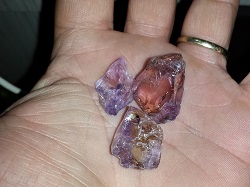AMETRINE:
Ametrine is a color-zoned variety of macrocrystalline quartz. It is sometimes referred to as trystine and is a natural
bicolor combination of amethyst and citrine. Color band combinations in ametrine can range from pale-violet to deep-purple
and from pale-yellow to gold-brown. Ametrine's color split is rather abrupt and is not a smooth blend of colors. Both the
violet and yellow colors found in ametrine are from traces of iron. The only difference between amethyst, citrine and ametrine
is the level of oxidized iron impurities in the visible color-zone bands. All three gemstones obtain their color from iron and
all three varieties have a silicon dioxide chemical composition.
There are very few naturally occurring yellow gemstones, including diamond, sapphire, tourmaline and chrysoberyl. However,
most tend to occur with more greenish tones. Beryl and topaz are known to occur with golden color. Golden topaz is known as
'imperial topaz' and golden beryl is known as 'heliodor'. Although amethyst is very abundant, natural citrine is considerably
rare and since citrine is rare, deposits of natural ametrine are very limited. The most desirable ametrine stones are those with
an even 50/50 split of color.

CLICK ON IMAGE TO SEE LARGER PICTURE
|

